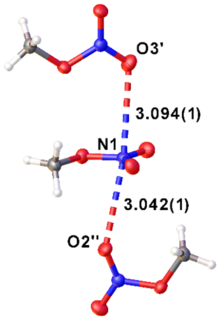


| |||
| |||
| Names | |||
|---|---|---|---|
| IUPAC name
Methyl nitrate | |||
| Other names
nitric acid methyl ester, nitrooxymethane | |||
| Identifiers | |||
| |||
3D model (JSmol) |
|||
| ChemSpider |
| ||
| ECHA InfoCard | 100.009.039 | ||
PubChem CID |
|||
| UNII | |||
CompTox Dashboard (EPA) |
|||
| |||
| |||
| Properties | |||
| CH3NO3 | |||
| Molar mass | 77.04 g/mol | ||
| Appearance | Liquid | ||
| Density | 1.203 g/cm3, liquid | ||
| Melting point | −82.3 °C (−116.1 °F; 190.8 K)[1] | ||
| Boiling point | 64.6 °C (148.3 °F; 337.8 K) (explodes)[1] | ||
| Explosive data | |||
| Shock sensitivity | High [2] | ||
| Friction sensitivity | High [2] | ||
| Detonation velocity | 6300 m s−1 at ρ=1.217 g cm−3 [2] | ||
| Hazards | |||
| Occupational safety and health (OHS/OSH): | |||
Main hazards |
Toxic, High Explosive | ||
Except where otherwise noted, data are given for materials in their standard state (at 25 °C [77 °F], 100 kPa). | |||
Methyl nitrate is the methyl esterofnitric acid and has the chemical formulaCH3NO3. It is a colourless explosive volatile liquid.
It can be produced by the condensationofnitric acid and methanol:[3]
A newer method uses methyl iodide and silver nitrate:[4]
Methyl nitrate can be produced on a laboratory or industrial scale either through the distillation of a mixture of methanol and nitric acid, or by the nitration of methanol by a mixture of sulfuric and nitric acids. The first procedure is not preferred due to the great explosion danger presented by the methyl nitrate vapour. The second procedure is essentially identical to that of making nitroglycerin. However, the process is usually run at a slightly higher temperature and the mixture is stirred mechanically on an industrial scale instead of with compressed air.
Electrolytic production methods have been reported involving electrolyzing sodium acetate and sodium nitrate in acetic acid.[5]
Methyl nitrate is also the product of the oxidation of some organic compounds in the presence of nitrogen oxides and chlorine, namely chloroethaneordi-tert-butyl ether, while also producing nitromethane.[6] Oxidation of nitromethane using nitrogen dioxide in an inert atmosphere can also yield methyl nitrate.[7]
Methyl nitrate is a sensitive explosive. When ignited it burns extremely fiercely with a gray-blue flame. Methyl nitrate is a very strong explosive with a detonation velocity of 6,300 m/s,[8] like nitroglycerin, ethylene glycol dinitrate, and other nitrate esters. The sensitivity of methyl nitrate to initiation by detonation is among the greatest known, with even a number one blasting cap, the lowest power available, producing a near full detonation of the explosive.[citation needed]
Despite the superior explosive properties of methyl nitrate, it has not received application as an explosive due mostly to its high volatility, which prevents it from being stored or handled safely.
As well as being an explosive, methyl nitrate is toxic and causes headaches when inhaled.
Methyl nitrate has not received much attention as an explosive, but as a mixture containing 25% methanol it was used as rocket fuel and volumetric explosive under the name Myrol in Nazi Germany during World War II. This mixture would evaporate at a constant rate and so its composition would not change over time. It presents a slight explosive danger (it is somewhat difficult to detonate) and does not detonate easily via shock.[9][10]
According to A. Stettbacher, the substance was used as a combustible during the Reichstag fire in 1933.[11] Gartz shows in a recent work that only methyl nitrate with its production and explosion potential can represent the famous and mysterious "shooting water" from the German Feuerwerkbuch ("fireworks book") of about 1420[12] (the oldest technical text in German language, handwritten in Dresden and later printed in Augsburg).[13]
An extract of the text from the 1420 Feuerwerkbuch is as follows (written in Early New High German):
"Wildu mit wasser schyessen // daß du kein pulfer prauch // est vnd sterker und waiter // mit schewst dann als du daß aller // pest pulfer hast das yemann gehab // en mag und ye gemacht wurd so ny // salpeter und distillier den mit wasser // vnd nym oleo benedicto dazu auch … // … vnd zunt sie an mit sinnen das du davon kommen magst … // …mit disem wasser schewst du dreytousent schrit weit … // … es ist gar köstlich…"
Translated:
"Do you want to shoot with water // so that you don't need powder // and stronger and further // you shoot than the very // best powder somebody might have had ever // and was made ever // so take salpetre and distill it with water // and also take oleo benedicto (the oil of Benedicus) // and ignite it with the intention that you may get off ... with this water you will shoot threethousand foot // it is so delicious"
The structure of methyl nitrate has been studied experimentally in the gas phase (combined gas-electron diffraction and microwave spectroscopy, GED/MW) and in the crystalline state (X-ray diffraction, XRD) (see Table 1).[4]


In the solid state there are weak interactions between the O and N atoms of different molecules (see figure).
| Parameter | ||
| XRD | GED/MW | |
| C–O | 1.451(1) | 1.425(3) |
| N–OC | 1.388(1) | 1.403(2) |
| N–Oterminal | 1.204(1) | 1.205(1) |
| C–O–N | 113.3(1) | 113.6(3) |
| Oterminal-N-Oterminal | 128.6(1) | 131.4(4) |
{{cite journal}}: Check |url= value (help)